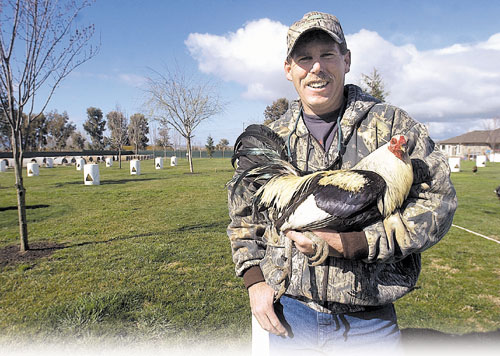
Frank Del Carlo’s rooster ranch on Pan Tempo Way east of
Hollister is more like a rooster resort for the several hundred Old
English gamecock that live there.
Hollister
Frank Del Carlo’s rooster ranch on Pan Tempo Way east of Hollister is more like a rooster resort for the several hundred Old English gamecock that live there.
The three varieties he raises on the farm have ample space, nice grass turf to strut on, clean shelters to roost in and a regimen of medications and vitamins meant to keep them disease free.
On Wednesday, Del Carlo gave a Free Lance reporter and photographer a behind-the-scenes look at his farm and state-of-the-art breeding facility off Lone Tree Road. The 39-year-old landscape company owner has put $300,000 into the place, turning it from a lifelong hobby into a business – while selling the chickens mainly for show purposes, but also for breeding, he said.
Even the USDA has applauded Del Carlo’s ranch, stating in a letter that “no one can even compare with the sanitary conditions displayed at (his) facility.” A state veterinarian makes monthly visits to the farm to inspect the chickens.
Health of the birds – or fear that illegal cockfights are being held at the ranch – have never been the concern, his lawyers contend.
The issue has been with the noise created from the more than 200 roosters on the ranch, and the county’s effort to appease complaining neighbors with a zoning ordinance aimed to quiet the fowl.
Del Carlo and Jimmy Hayhurst, a Southside Road resident who also raises roosters, will square-off against county officials in court on Monday, challenging the ordinance that was passed in March 2006.
“It’s a property rights issue,” said John Cogorno, a Southern California attorney representing Del Carlo. “If we have to, we’ll go all the way to the Supreme Court with this.”
Cogorno claims the county has conspired to take away Del Carlo’s right to farm.
Supervisor Don Marcus, who originally fielded complaints from neighbors on Lone Tree Road in his district, said county counsel advised the board not to discuss the ordinance or related issues as it heads into litigation next week.
“I feel really uneasy answering questions on this topic,” Marcus said.
It took the county about a year to draft and implement the ordinance, which limits the amount of crowing fowl property owners may hold to less than 10 and only one per acre. More than six crowing fowl requires an administrative permit, and those with more than 10 must go before the planning commission for a conditional permit.
Del Carlo and Hayhurst claim the county told them they’d be grandfathered in under the ordinance.
But they were not, as the ordinance made an exception only for those who had been raising roosters on the property for more than three years.
The two also contend they were not properly notified about hearings to discuss the ordinance.
And Del Carlo said he has kept the roosters 150 feet away from the property line to limit the noise for his neighbors.
“I’ve tried to be appeasing and work with the people who are complaining,” Del Carlo said.
Another of Del Carlo’s attorneys, Bill Marder, even said the community should be proud of his client’s facility.
“The USDA gave this place the highest rating you can give it,” Marder said.
Court documents filed in November show the county counsel contends that Del Carlo and Hayhurst’s “raising and keeping of crowing fowl does not constitute an agricultural processing activity, operation, facility and/or appurtenance,” as it is protected under California Civil Code.









